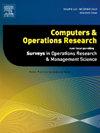考虑利润与浪费的易腐产品动态库存控制与定价策略
IF 4.1
2区 工程技术
Q2 COMPUTER SCIENCE, INTERDISCIPLINARY APPLICATIONS
引用次数: 0
摘要
随着世界范围内对可持续性考虑的增加,业界和学术界对易腐产品的有效管理越来越感兴趣。有必要控制库存,以及易腐产品的价格,以增加利润,同时尽量减少浪费。在本研究中,我们关注的是一家销售新旧易腐食品的零售商,该零售商能够根据产品的价格和消费者行为实现产品之间的需求转移。建立了易腐食品的双目标动态规划模型,对易腐食品的折扣价格、销售价格和订单数量进行优化,使零售商的利润最大化,食品浪费最小化。我们制定了四种常用的静态和动态定价政策,并从利润和浪费两方面量化了动态定价和新旧产品价格差异的优势。我们的研究结果表明,当考虑手头的可用库存,以动态方式给出订单数量和旧产品的销售价格决策时,可以获得显著的效益。此外,本研究还分析了目标函数中利润和浪费的各种权重组合的结果。研究结果强调了浪费和可持续性问题的重要性,强调了利润与浪费之间的权衡,并为公司提供了改进其系统结果的见解。本文章由计算机程序翻译,如有差异,请以英文原文为准。
Dynamic inventory control and pricing strategies for perishable products considering both profit and waste
With the increasing sustainability considerations throughout the world, there is an increasing interest in the effective management of perishable products both in the industry and the academia. There is a need to control the inventories, as well as the prices of perishable products in order to increase the profits while minimizing the waste. In this study, we focus on a retailer who sells old and new perishable food products, enabling demand shifts between products based on their prices and consumer behaviors. A bi-objective dynamic programming model is developed to optimize the discounted price, sale price, and order quantity of perishable food products in order to maximize the retailer’s profit and minimize food waste. We develop four static and dynamic pricing policies commonly practiced and quantify the advantages of dynamic pricing and price differentiation between old and new products in terms of both profit and waste. Our findings reveal that significant benefits can be obtained when the order quantity and the old product’s sale price decisions are given in a dynamic manner by considering the available inventory at hand. Additionally, this research analyzes the results of various weight combinations for profit and waste in the objective function. The findings highlight the significance of waste and sustainability concerns, underline the tradeoff between profit and waste and provide insights to companies to achieve improvements in their system results.
求助全文
通过发布文献求助,成功后即可免费获取论文全文。
去求助
来源期刊

Computers & Operations Research
工程技术-工程:工业
CiteScore
8.60
自引率
8.70%
发文量
292
审稿时长
8.5 months
期刊介绍:
Operations research and computers meet in a large number of scientific fields, many of which are of vital current concern to our troubled society. These include, among others, ecology, transportation, safety, reliability, urban planning, economics, inventory control, investment strategy and logistics (including reverse logistics). Computers & Operations Research provides an international forum for the application of computers and operations research techniques to problems in these and related fields.
 求助内容:
求助内容: 应助结果提醒方式:
应助结果提醒方式:


